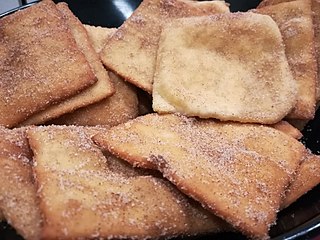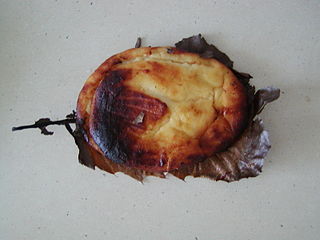
A doughnut or donut is a type of pastry made from leavened fried dough. It is popular in many countries and is prepared in various forms as a sweet snack that can be homemade or purchased in bakeries, supermarkets, food stalls, and franchised specialty vendors. Doughnut is the traditional spelling, while donut is the simplified version; the terms are used interchangeably.

Tempura is a typical Japanese dish that usually consists of seafood and vegetables that have been coated in a thin batter and deep fried. Tempura has its origins dating back to the 16th century, when Portuguese Jesuits brought the Western-style cooking method of coating foods with flour and frying, via Nanban trade.

Beignet is a type of deep-fried pastry of French origin. It is commonly made from pâte à choux, but can also be made using rice flour or yeast-leavened batters. Beignets can be served in a variety of preparations, the most common being dusted with confectioner’s sugar. The pastry is popular in French, Italian, and American cuisines.

Calas are dumplings composed primarily of cooked rice, yeast, sugar, eggs, and flour; the resulting batter is deep-fried. It is traditionally a breakfast dish, served with coffee or cafe au lait, and has a mention in most Creole cuisine cookbooks. Calas are also referred to as Creole rice fritters or rice doughnuts.

Ukrainian cuisine is the collection of the various cooking traditions of the people of Ukraine, one of the largest and most populous European countries. It is heavily influenced by the rich dark soil (chornozem) from which its ingredients come, and often involves many components. Traditional Ukrainian dishes often experience a complex heating process – "at first they are fried or boiled, and then stewed or baked. This is the most distinctive feature of Ukrainian cuisine".

A fritter is a portion of meat, seafood, fruit, vegetables, or other ingredients which have been battered or breaded, or just a portion of dough without further ingredients, that is deep-fried. Fritters are prepared in both sweet and savory varieties.

A sopaipilla, sopapilla, sopaipa, or cachanga is a kind of fried pastry and a type of quick bread served in several regions with Spanish heritage in the Americas. The word sopaipilla is the diminutive of sopaipa, a word that entered Spanish from the Mozarabic language of Al-Andalus. The original Mozarabic word Xopaipa was used to mean bread soaked in oil. The word is derived in turn from the Germanic word suppa, which meant bread soaked in liquid.

A buñuelo (Spanish:[buˈɲwelo], alternatively called boñuelo, bimuelo, birmuelo, bermuelo, bumuelo, burmuelo, or bonuelo, is a fried dough fritter found in Spain, Latin America, and other regions with a historical connection to Spaniards, including Southwest Europe, the Balkans, Anatolia, and other parts of Asia and North Africa. Buñuelos are traditionally prepared at Christmas. It will usually have a filling or a topping. In Mexican cuisine, it is often served with a syrup made with piloncillo.

Panelle are Sicilian fritters made of chickpea flour and other ingredients, usually including water, salt, pepper, olive oil, and finely chopped parsley. They are a popular street food in the city of Palermo and are often eaten between slices of bread or on a sesame roll, like a sandwich. These sandwiches, called pane e panelle, are usually served with a slice of lemon to be squeezed over the panelle.

Corn fritters are fried cakes of a dough or batter made of, or containing a featured quantity of maize (corn). Originating in Native American cuisine, they are a traditional sweet and savory snack in the Southern United States, as well as Indonesia where they are known as perkedel jagung or bakwan jagung.

Falculelle are a typical dessert of the Corsican cuisine.

The cuisine of Corsica is the traditional cuisine of the island of Corsica. It is mainly based on the products of the island, and due to historical and geographical reasons, has much in common with Italian cuisine, and marginally with those of Nice and Provence.
Canestru is a Corsican cake generally shaped as a circle, made of brioche dough. The cake is typical of the cuisine of Corsica and originates from the village of Petreto-Bicchisano in Corse-du-Sud. Canestru is a traditional Easter cake, and is typically consumed during the traditional Easter Monday picnic.
Campanile, meaning "the bell tower", pl. campanili) is a Corsican cake generally shaped like a crown, made of yeast dough. It is a typical dessert of the cuisine of Corsica and is a traditional Easter cake: the boiled eggs in the cake look like little bells inside the bell tower and represent the renewed fertility of the earth after the end of winter, remembering also the tradition to unleash the bells at Easter, after having tethered them at Good Friday.

Cacavellu is a Corsican cake generally shaped as a crown, made of yeast dough. It is a typical dessert of the village of Vico.

Inuliata is a Corsican cake generally shaped as a circle, made of yeast dough. The cake is typical of the cuisine of Corsica and originates from the city of Ajaccio in Corse-du-Sud. Inuliata is prepared during the Easter week.
Strenna is a Corsican pie having generally a round shape. The pie is typical of the cuisine of Corsica and originates from the city of Vico in Corse-du-Sud. Strenna is prepared for New Year's Day, and given as present by villagers to relatives coming to offer new year's wishes.

Zalabiyeh is a fritter or doughnut found in several cuisines across the Arab world, West Asia and some parts of Europe influenced by the former. The fritter version is made from a semi-thin batter of wheat flour which is poured into hot oil and deep-fried. The earliest known recipe for the dish comes from a 10th-century Arabic cookbook and was originally made by pouring the batter through a coconut shell.

Neccio, also called niccio, ciaccio, or cian, is a galette based on chestnut flour, typical of some mountain zones of Tuscany and Emilia, in Italy, and of the island of Corsica, in France.

















